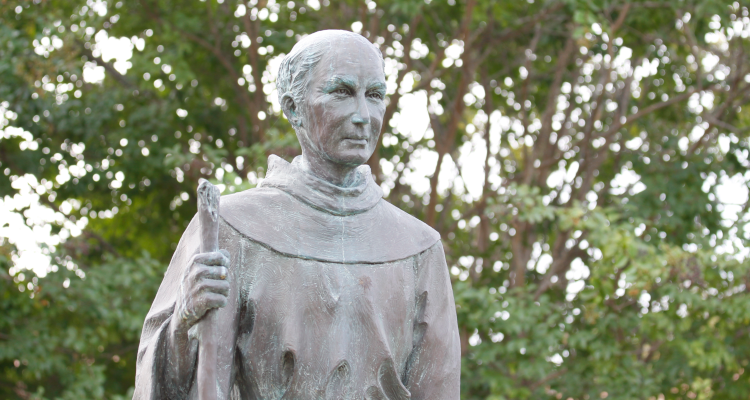- Home
-
About
 Fidelity & Excellence
Fidelity & ExcellenceThomas Aquinas College is unique among American colleges and universities, offering a faithfully Catholic education comprised entirely of the Great Books and classroom discussions.
-
A Liberating Education
 Truth Matters
Truth MattersTruth, and nothing less, sets men free; and because truth is both natural and supernatural, the College’s curriculum aims at both natural and divine wisdom.
-
A Catholic Life
 Under the Light of Faith
Under the Light of FaithThe intellectual tradition and moral teachings of the Catholic Church infuse the whole life of Thomas Aquinas College, illuminating the curriculum and the community alike.
-
Admission & Aid
 Is TAC Right for You?
Is TAC Right for You?Do you enjoy grappling with complex questions? Are you willing to engage in discussions about difficult concepts, with the truth as your ultimate goal?
-
Students & Parents
 Mind, Body & Spirit
Mind, Body & SpiritThere is always something to do at TAC — something worthwhile, something fulfilling, and something geared toward ever-greater spiritual and intellectual growth.
-
Alumni & Careers
 What Can You Do with a Liberal Education?
What Can You Do with a Liberal Education?Nothing speaks more to the versatility of the College’s academic program than the good that our alumni are doing throughout the Church and the world.
- Search
- Giving
Alumnus Attorney Takes to Airwaves to Defend St. Junípero Serra

For years, the legacy of St. Junípero Serra has been under attack, both in California and beyond, by those who seek to lay at his feet all the crimes of colonialism. Most recently Gov. Gavin Newsom signed into law a bill which not only keeps St. Junípero’s once-revered statue out of the state capitol, but also condemns California’s Franciscan evangelist for offenses ranging from slavery to genocide.
Those charges amount to “slander,” according to the state’s two archbishops, the Most Rev. José H. Gomez of Los Angeles and the Most Rev. Salvatore J. Cordileone of San Francisco — in a recent op-ed in the Wall Street Journal. “While there is much to criticize from this period,” the archbishops acknowledge, “no serious historian has ever made such outrageous claims about Serra or the mission system, the network of 21 communities that Franciscans established along the California coast to evangelize native people.”

To speak about St. Junípero, his legacy, and the archbishops’ commentary, alumnus attorney Patrick Laurence (’96) recently appeared on Ave Maria Radio’s Kresta in the Afternoon program. “A lot of these allegations are anchored in what could be legitimate criticisms,” Mr. Laurence told guest host Matthew Bunson. “But then they just expand into these outrageous charges of slavery and genocide which are just, plain and simple, not accurate.”
A senior associate at the firm of Murtaugh, Treglia, Stern & Deily LLP — and a member of the College’s Orange County Board of Regents — Mr. Laurence has a deep interest in the California saint, for whom a strong devotion exists on TAC’s California campus. He has presented a talk, “Junípero Serra on Trial: Criminal or Saint?”, to numerous audiences, including nationally syndicated radio programs.
Far from being the “concentration camps” that revisionists allege, Mr. Laurence argued on Kresta in the Afternoon, the California missions protected indigenous people from exploitation and abuse. “The way the missions operated,” he explained, was on the idea that “the indigenous people in the new world were a vulnerable population, that they were being exploited, in some instance enslaved, in the new world, and so we needed to segregate them.” This separation, he continued, was to be voluntary: “Spanish law is very clear about that: They cannot be forced into the missions. But the idea was that they needed to be segregated there … because there had been a very long history of Spanish settlers exploiting their labor, enslaving them.”
Indeed, St. Junípero once made the arduous journey, by foot, all the way from Alta, California, to Mexico City to plead to the viceroy for the protection of natives, who were being sexually abused by members of the Spanish military. “One of the provisions which he asked for, which was actually granted by the viceroy,” noted Mr. Laurence, “was to enable the missionaries in California to request that soldiers be removed if they were accused of what Serra referred to as ‘crimes against chastity or continence.’”
The abuses of natives in California were horrific, but not the work of St. Junípero, who sacrificed a life of comfort in Spain to defend and bring Jesus to his brothers and sisters in the New World. “He was concerned solely with spreading the Gospel and ministering the Sacrament of Baptism to the indigenous,” observed Mr. Laurence. “He knew what he was doing, and he gave up all of that to serve as a missionary.”

